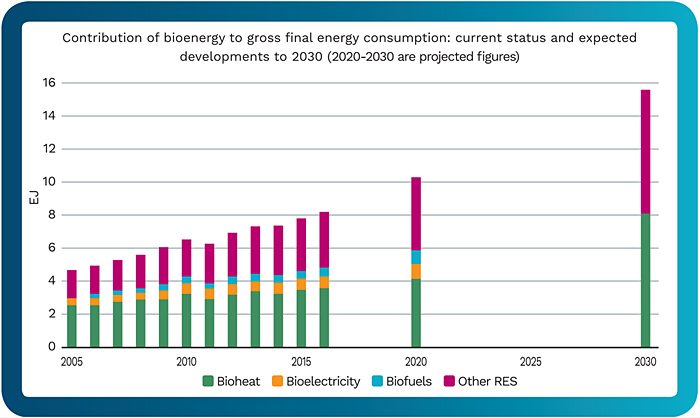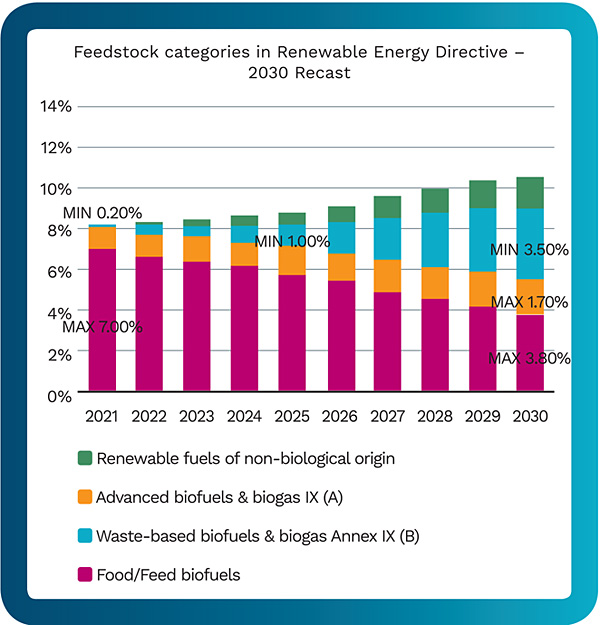Bioenergy is currently the main Renewable Energy Source (RES) in the European Union (EU), accounting for 65% of the EU renewable energy consumption. It’s considered a key pillar for the achievement of energy and climate targets, both at EU and global level. As acknowledged in the “A Clean Planet for all” (COM(2018) 773 final) communication, sustainable bioenergy is expected to facilitate a net-zero GreenHouse Gas (GHG) emissions economy, with estimates of its use pointing to an increase of around 80% by 2050 compared to today’s levels, up to 10.5 EJ (250 Mtoe).
Biomass can not only generate electricity, but it can also produce heat and transport fuels, as well as bio-based materials and bio-chemicals. Most importantly, bioenergy can play an important role in decarbonising sectors where other options are unavailable or are very limited, such as freight road transport, aviation and maritime transport. Besides contributing to GHG reduction, bioenergy brings additional social, environmental and economic benefits to agriculture, forestry and other industrial sectors driving rural development, in the context of sustainable development.
While there are legitimate concerns over the sustainability aspects and carbon emissions related to large-scale bioenergy expansion, most studies demonstrate that substantially lower GHG emissions, compared to fossil energy, are achievable if induced impacts on the use of land are avoided, biomass is produced with low (fossil) energy input (or derived from residue and waste streams) and if it’s processed with high conversion efficiency using renewable process energy.

The recently adopted (Directive (EU) 2018/2001), regulating bioenergy and biofuels within the broader frame of Renewable Energy Sources includes a binding renewable energy target for the EU of 32% by 2030, with an upwards revision clause by 2023. The sustainability Recastof bioenergy is of paramount relevance, i.e. it must deliver optimal greenhouse gas (GHG) savings and it must be produced according to strict sustainability requirements. These sustainability criteria include restrictions on biomass production in high biodiversity value land (primary forests, highly biodiverse forest, protected areas and highly biodiverse grasslands) and in high-carbon stock land, such as wetlands, forest land and peatland. Furthermore, forest biomass needs to comply with Land-Use, Land-Use Change and Forestry (LULUCF) criteria.

Combined heat and power (CHP) provides currently 11 % of Europe’s electricity and 14 % of its heat. Biomass fuelled CHP had about 21% from the total CHP market of in the EU in 2017. The Scandinavian countries with large forestry biomass resources have the highest penetrations rates.
As for biofuels, the Directive ensures that the share of renewable energy allocated for final consumption in the transport sector (road and rail) reaches at least 14% by 2030. The contribution of biofuels derived from food and feed crops is capped at 7%. Within the overall 14% quota, the contribution of the so-called advanced biofuels shall be equal to at least 0.2% in 2022, 1% in 2025 and increasing up to 3.5% minimum by 2030.
Bioenergy has a primary role to play on the road to a low-carbon energy system, by allowing higher integration of variable, intermittent sources of renewable energy (such as wind and solar) into energy systems. Biomass power production can be used to deliver continuous electricity or grid balancing, offering certain flexibility capability in operation. A number of bioenergy solutions are currently available and are applied at various size ranges to enable flexible power generation. Integrated bioenergy hybrids offer flexible solutions applicable to both energy supply and energy storage, including solar thermal systems, Concentrated Solar Power (CSP), geothermal, heat pumps, waste heat recovery, etc.
Bioenergy can be competitive in some cases, especially when cheap or even negative cost of biomass feedstock, such as waste and residues, is available. While a number of bioenergy technologies approach maturity, further technology development is needed to allow promising technologies to reach commercial production and to achieve cost competitiveness.
The main focus is to close the gap between research and innovation and industrial implementation of innovative technologies. In this respect, the European Commission adopted a Communication for an Integrated Strategic Energy Technology Plan (C(2015) 6317 final), which identifies ten priority actions aimed at accelerating the transformation in the energy system through coordinated or joint investments between EU Member States, private stakeholders (including research and industry) and the European Commission. The Implementation Plan (IP) of Action 8, Bioenergy and Renewable Fuels for Sustainable Transport, proposes to prioritise the execution of Research and Innovation (R&I) activities to achieve the SET Plan targets for renewable fuels for transport, other renewable fuels of non-biological origin, bioenergy intermediate carriers, renewable hydrogen and large-scale biomass CHP.
As the European Commission’s Science and Knowledge Service, the Joint Research Centre supports EU policies in the field of bioenergy and biofuels, covering the entire policy cycle from research and innovation to implementation of regulatory acts.